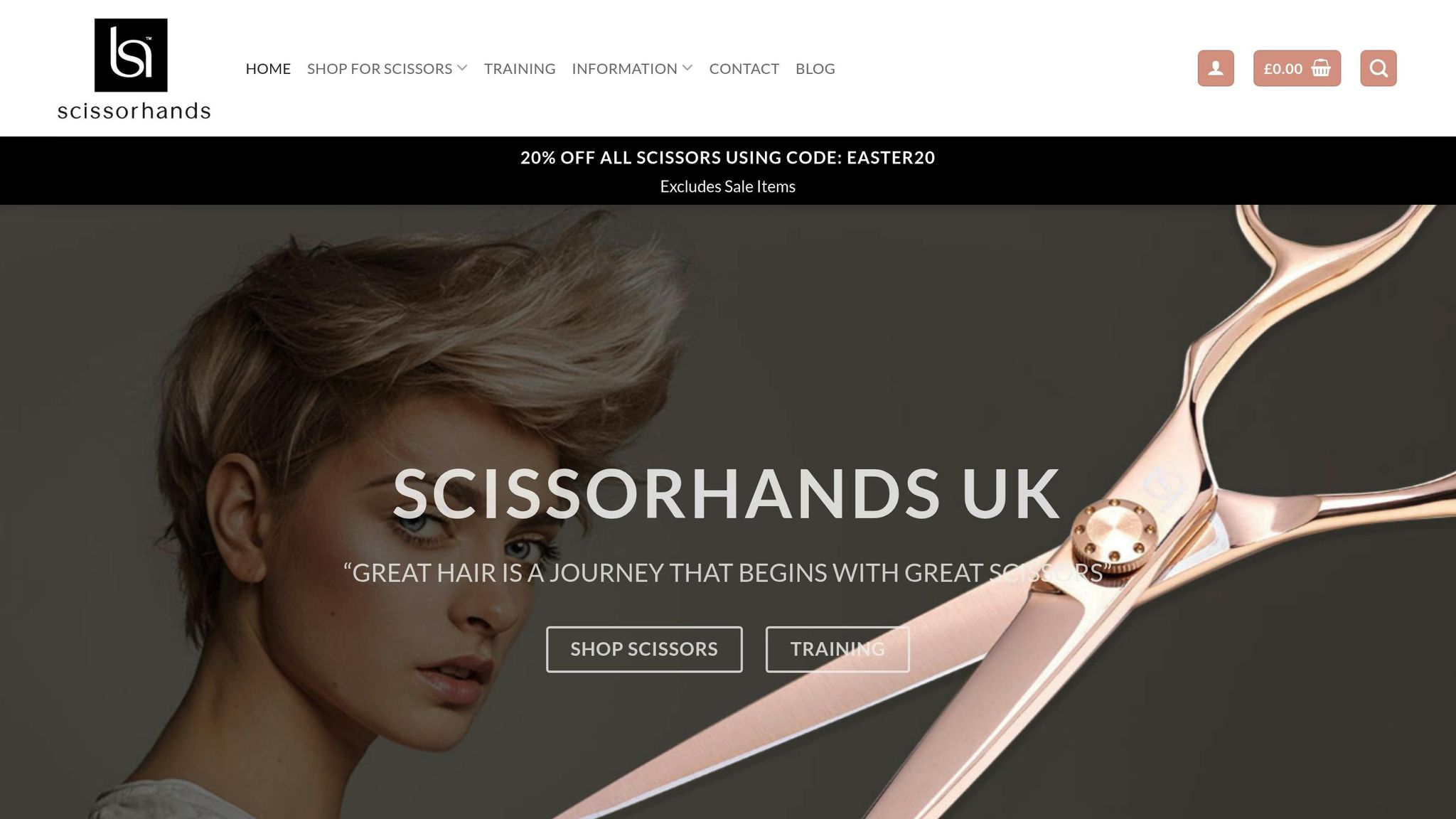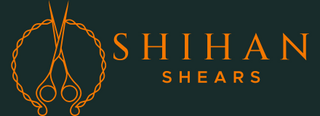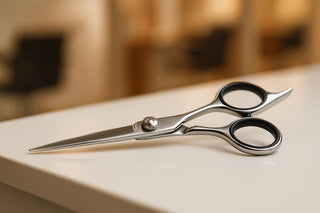Investing in the right professional hair cutting shears can improve your precision, reduce hand fatigue, and extend the life of your tools. Here's what you need to know:
- Price Range: Entry-level shears start at $50, while professional-grade shears typically cost $200–$800. Premium models can exceed $1,500.
- Materials: Japanese steel, like ATS-314, is highly durable, sharp, and rust-resistant.
- Ergonomics: Features like offset handles, swivel thumbs, and forward-set thumbs reduce strain and prevent injuries.
-
Blade Types:
- Convex edges: Best for advanced techniques like slide cutting; cost $250–$800.
- Beveled edges: Affordable and durable, suitable for basic cuts under $200.
-
Shear Types:
- Short shears (4–5.5 inches): Ideal for precision work.
- Thinning shears: Blend layers and reduce bulk.
- Long shears (6–7 inches): Handle thick hair and large sections.
Maintenance Tips:
- Clean daily, especially after cutting treated hair.
- Oil weekly and store in a protective case.
- Adjust tension regularly and schedule professional servicing annually.
Quick Takeaway: High-quality shears, particularly those made from Japanese steel, are a long-term investment that ensures better cuts, less fatigue, and a longer lifespan for your tools.
A Buyers Guide to Choosing the Right Hairdressing Scissors | Scissorhands UK

How to Select Professional Hair Cutting Shears
When choosing hair cutting shears, focus on technical details that affect how they perform and how comfortable they are to use. Let’s break down the role of steel quality, ergonomic design, and blade edge types in shaping your cutting experience.
Steel Quality: Why Japanese Steel Stands Out
Japanese steel is known for its hardness and durability. Premium grades like ATS-314 have Rockwell Hardness ratings between 59 and 61, making them a top choice for professional shears. High-quality steel typically includes:
- 0.95–1.2% carbon for added strength
- Molybdenum to resist rust
- Cobalt and titanium to make the shears lighter
- Vanadium to improve balance
Manufacturers like Hitachi Metals, founded in 1956, are leaders in producing ATS-314 steel. This steel contains high levels of cobalt, titanium, and vanadium, making it far superior to standard 420-grade steel, which has a lower Rockwell rating of 50–55.
Comfort Features: Designed to Ease Hand Strain
Ergonomic shears are essential for reducing hand and wrist fatigue, especially during long cutting sessions. Look for features that promote comfort and prevent strain:
| Feature | Benefit | Ideal For |
|---|---|---|
| Offset Handles | Keeps wrist in a neutral position | All-day cutting |
| Forward-set Thumb | Reduces strain on the thumb | Detailed work |
| Swivel Mechanism | Supports natural hand movement | Advanced techniques |
These features help prevent repetitive stress injuries by encouraging a relaxed grip and minimizing thumb extension or wrist bending. The right design can make a big difference in your comfort and precision.
Edge Types: Choosing Between Convex and Beveled Blades
The type of blade edge you choose has a big impact on your cutting techniques. Here’s a quick comparison:
- Convex edges are perfect for advanced techniques like slide and point cutting, whether you're working on wet or dry hair. They deliver excellent performance but come at a higher cost, ranging from $250 to $800.
- Beveled edges are more affordable (usually under $200) and durable. While they require more cutting force, they’re great for basic techniques like scissor-over-comb work and clean, blunt cuts.
For maximum flexibility, it’s a good idea to have shears with both edge types. Match your choice to your cutting style and experience level to get the best results.
Shear Types for Different Cutting Methods
Choosing the right type of shears for your cutting technique is just as important as selecting quality steel and ergonomic designs. Once you're familiar with key features, the right shear can elevate your cutting precision and efficiency.
Short Shears: Perfect for Precision Work
Short shears, typically 4 to 5.5 inches long, are ideal for detailed, close-range cutting. Their compact size makes them great for pixie cuts, adding texture with point cutting, palm-to-palm techniques, and in-hand cutting. These shears are lightweight, helping reduce hand fatigue during long sessions. A 5.5-inch shear is an excellent choice for fine, intricate work, while other techniques may call for different shear types.
Thinning Shears: Reducing Bulk and Adding Texture
Thinning shears are designed to blend layers and manage hair density by selectively removing bulk. The number of teeth on the shears determines their effect:
- High tooth count (20–40 teeth): Best for subtle blending, removing only a small amount of hair with each cut.
- Moderate tooth count (14–20 teeth): Great for creating natural-looking layers.
- Low tooth count (5–14 teeth): Produces a chunkier, more textured finish.
For a natural blend, hold the thinning shears about 1–2 inches away from the scalp.
Long Shears: Ideal for Thick Hair
Long shears, ranging from 6 to 7 inches, are essential for managing thick or coarse hair. Their extended blades allow for smooth, consistent cuts, making them perfect for techniques like scissor-over-comb and straight-line cutting. A 6.8-inch shear offers the leverage needed for thicker hair while providing the control to follow the natural curves of the head, resulting in a seamless, organic finish.
sbb-itb-a50b05d
Shear Care and Maintenance
With proper upkeep, high-quality shears can last 12–15 years. On the flip side, neglecting maintenance can reduce their lifespan to just 4–5 years.
Sharpening Schedule and Methods
Keeping your shears in good shape involves more than just sharpening. Regular cleaning, proper tension adjustment, and balancing are all key to maintaining their performance.
"We recommend having any shears that you use on a regular basis serviced at least once a year. They need to be cleaned, set and balanced, even if they are still sharp within that year period." - Scissor Mall
Here’s how to extend the life of your shears:
- Daily cleaning: Especially after cutting permed, colored, or chlorinated hair.
- Weekly oiling: Apply oil to the pivot point to minimize friction.
- Proper storage: Always keep shears in their protective case.
- Annual servicing: Schedule professional maintenance at least once a year.
Lower-quality shears may need sharpening up to four times annually, which not only shortens their lifespan but also adds to maintenance costs. Blade sharpness and proper tension go hand in hand - both are essential for precision cutting.
Tension Settings and Adjustments
Correct tension is critical for clean cuts and to avoid unnecessary wear and tear on your shears. Incorrect tension can lead to fatigue and even damage the blades.
To check your shear tension, follow this simple test: Hold the shears vertically, open one blade to a 90-degree angle, and let it go. The blade should close about two-thirds of the way naturally.
| Tension | Signs | Result |
|---|---|---|
| Too Tight | Minimal blade movement | Causes fatigue and wear |
| Too Loose | Snaps shut too quickly | Leads to uneven cuts |
| Optimal | Closes 2/3 smoothly | Produces clean, precise cuts |
When adjusting tension, make small changes using the appropriate tool, whether it’s a tension key, screwdriver, or built-in dial system. Thinning shears need extra care since improper tension can damage their fine teeth.
Regular maintenance should always include tension testing and adjustments. If your shears start pushing hair instead of cutting it cleanly, it’s often a tension issue - not dull blades.
Conclusion: Choosing Your Professional Shears
Selecting the right hair cutting shears can make a big difference in your performance and comfort. High-quality shears made from Japanese steel typically cost between $250 and $500, but they last much longer than cheaper options that may wear out in just a few months.
Here’s a quick guide to key features:
| Feature | Why It Matters | What to Look For |
|---|---|---|
| Blade Length | Impacts cutting techniques | 5.5"–6.0" blades handle about 80% of techniques |
| Handle Design | Affects comfort and reduces strain | Crane handles with forward/swivel thumb grips |
| Steel Quality | Determines durability and sharpness | Japanese steel like VG-10 or ATS-314 |
| Maintenance | Keeps shears performing well | Professional servicing every 6–12 months |
Most stylists find 5.5"–6.0" blades ideal for precision work, while longer blades are better for cutting larger sections of hair. Your choice should align with the techniques you use most often.
To keep your shears in top condition, regular maintenance is crucial. This includes cleaning, adjusting tension, and scheduling professional servicing at least once a year. Investing in high-quality shears is a smart move for long-term success in your craft.
FAQs
What’s the difference between convex and beveled blade edges, and which one is right for my cutting techniques?
Convex blades feature a smooth, curved edge that provides an incredibly sharp and precise cut, making them perfect for advanced techniques like slide cutting and texturizing. However, they are more delicate and require careful handling.
Beveled blades, on the other hand, have a distinct angled edge that is more durable and versatile. They’re great for blunt cuts and basic techniques but may not deliver the same level of precision for intricate styles.
When choosing between the two, consider your cutting style and the techniques you use most often. If precision and advanced methods are your focus, convex blades might be the better option. For durability and versatility in everyday cuts, beveled blades are an excellent choice.
Why is Japanese steel, like ATS-314, considered ideal for professional hair cutting shears?
Japanese steel, particularly ATS-314, is highly regarded in the hairdressing industry due to its exceptional durability and sharpness. Known for its superior hardness (HRC 64), this steel allows shears to maintain their edge for extended periods, reducing the need for frequent sharpening.
Shears made from ATS-314 not only deliver precise, clean cuts but also provide long-term reliability, making them a worthwhile investment for professionals who demand high performance and longevity from their tools.
What ergonomic features should I look for in hair cutting shears to reduce hand fatigue and avoid injuries during long styling sessions?
To reduce hand fatigue and avoid injuries during extended styling sessions, focus on ergonomic features that prioritize comfort and support. Look for shears with offset or crane-style handles, as these designs help maintain a more natural hand position and reduce strain compared to straight-handled shears.
Additionally, choose shears that feel balanced and lightweight in your hand. A well-balanced pair ensures that neither the blade nor the handle feels too heavy, making it easier to work for long periods without discomfort. Testing the shears in your hand before purchasing can help you find the perfect fit for your needs.

